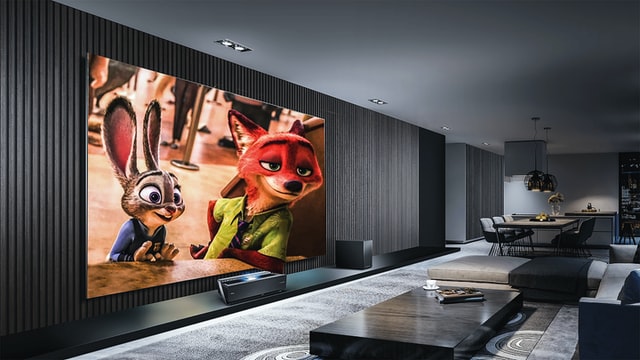Projectors do not display the color black since a projector transmits a beam of light onto a wall or a projection screen to produce an image, the areas of the image that appear black are actually a very faint gray.
Contents
How does a projector project black on a screen?
The black of a projected image is caused by the darkness of the room as well as the way the eye and brain interpret contrast. The screen is white or has a light-reflective surface. When you turn off the lights, any area of the projected image will be completely black. The image’s dark areas are merely areas where no light is projected.
Because of the way our visual system works, unlit (black) regions appear darker than they actually are. When we observe a picture with bright regions, we interpret the dark portions to be significantly darker. We have a tendency to view objects in terms of relative brightness and color. When placed next to a brilliant white, a neutral grey will seem black. If you have a mainly red picture, neutral colors will seem to be greenish-blue.
This is especially noticeable on your television, as it also applies to backlighting. Set the lights in the room as you would for watching TV. Now take a seat and gaze at the screen. When the TV is switched on, what you see there is what you perceive as darkness. Unless you have an expensive high-end TV, your black will be a little lighter due to light leakage.
How do we see color?
Have you ever considered how our eyes absorb color and why certain items are red and others are blue? It all begins with the physics of white light. White light is created by combining all of the visible color spectrum’s hues.
We may infer that white light contains all hues because of this characteristic of white (except for black, which is technically not a color but a hue). When white light strikes an item, it is either reflected or absorbed. The color is reflected rather than absorbed in the color we perceive.
When we perceive red in an apple, we are actually seeing the red reflected by the apple rather than the red in the fruit itself. The apple absorbs all colors except red from white light, which is why the cones in the eye (three types of eye cones: blue, green, and red) allocated to detecting red light sends signals to your eye-brain that it perceives red.
So, when we see a red apple, the red is not truly inside the apple, but rather the color that is not reflected by the apple (so technically, the apple is not red, but the apple does reflect the color red).
The black projection
When you hear that blacks are the polar opposite of whites, you are correct! If white is the mixture of all hues, then black is the absence of all colors, which occurs when all light is absorbed but none is reflected.
Because projectors are dependent on light, they cannot display a color that reflects the lack of light. That would be not just ironic, but also scientifically impossible. To make things easier, projectors do not project the color black.
Why is the projector’s interaction with black so complex?
Because projectors do not project black, the black you see on the projection is largely dependent on a variety of circumstances. We’ll talk about improving the contrast of your projector later.
However, in this portion of the essay, we will look at the variables that influence the color black in projectors.
Human eyes are a perplexing pair of flesh. They are not only incredibly complicated, but they also fill their physical limits with the brain’s cognitive skills when they work together with the brain (just like how smartphones have AI post-processing built-in on their cameras).
Our eyes see colors in relation to the colors around them. That instance, if a really dark color is placed over a sea of white, it may appear considerably darker than it is. As an example, consider the image below.
Take note of the two gaps that surround the dots in the image. Even though one appears lighter and the other appears darker, they are both the same color
You may be wondering how this relates to projectors in particular. It may appear dark if the projected picture comprises blacks surrounded by many brighter, vivid colors. However, if the projected picture’s black images are juxtaposed with reasonably dark images, the projected image may not appear dark.
The surface is critical
Because blacks on a projector are not reflected, blacks on projected pictures will vary greatly depending on the projected surface.
It implies that if a projector is aimed at a brightly lit surface, the black may not be as deep as intended. On the other hand, if the projector is aimed onto a dark object, such as a black-painted wall, the blacks will be exceedingly dark.
Let us look at the image below for reference. In an ideal world, a projector would produce perfect blacks, as seen in the image on the left.
In actuality, however, most projector blacks will be influenced by how the projected surface appears and will seem similar to the one shown on the right.
FAQs
Can black be projected?
If there is no light, there is nothing for you to see. Black is not a color; it is just the absence of light. Mostly, black is “projected” by not projecting any light. The black you see on the darkened screen surface is caused by the projector’s partial absence of light.
How do I make my projector black?
Set your projector’s brightness to the ideal level. To do this, play a widescreen DVD or another video color black bar on the screen. Turn your projector’s brightness setting up until the bars are grey, then gradually lower it until they are black.
Why are projector screens not black?
Light is absorbed by black materials. Projecting onto a black screen would actually make it more difficult to view since most of the light would be absorbed, necessitating the use of a much more powerful projector to compensate. Silver and white, on the other hand, reflect the greatest amount of light. This means you don’t need as powerful a projector.
What color screen is best for a projector?
Gray screens are also known as high contrast screens because they are used to increase contrast on digital projectors in non-completely dark viewing rooms. A gray screen absorbs ambient light more effectively than a white screen. The black level on the screen is maintained as a result.
Conclusion
Finally, the color black is determined by the surface onto which you are projecting. When you watch a movie or television on it, it gets the darkest it can get. Simply said, projectors attempt not to cast any more light onto the surface.
As an example, consider an off-white screen in a bright environment. That is as dark as it gets. To show a picture, the projector can only try to make the white bits brighter than that (called contrast ratio).
Further Reading:





